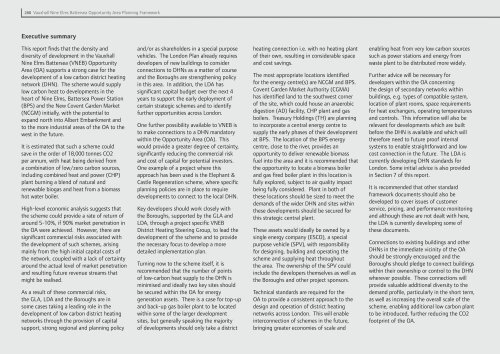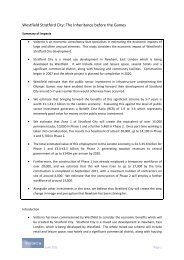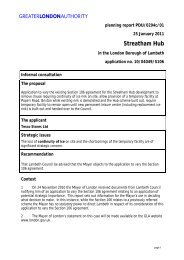Vauxhall Nine Elms Battersea Opportunity Area Planning Framework
Vauxhall Nine Elms Battersea Opportunity Area Planning Framework
Vauxhall Nine Elms Battersea Opportunity Area Planning Framework
Create successful ePaper yourself
Turn your PDF publications into a flip-book with our unique Google optimized e-Paper software.
280 <strong>Vauxhall</strong> <strong>Nine</strong> <strong>Elms</strong> <strong>Battersea</strong> <strong>Opportunity</strong> <strong>Area</strong> <strong>Planning</strong> <strong>Framework</strong>Executive summaryThis report finds that the density anddiversity of development in the <strong>Vauxhall</strong><strong>Nine</strong> <strong>Elms</strong> <strong>Battersea</strong> (VNEB) <strong>Opportunity</strong><strong>Area</strong> (OA) supports a strong case for thedevelopment of a low carbon district heatingnetwork (DHN). The scheme would supplylow carbon heat to developments in theheart of <strong>Nine</strong> <strong>Elms</strong>, <strong>Battersea</strong> Power Station(BPS) and the New Covent Garden Market(NCGM) initially, with the potential toexpand north into Albert Embankment andto the more industrial areas of the OA to thewest in the future.It is estimated that such a scheme couldsave in the order of 18,000 tonnes CO2per annum, with heat being derived froma combination of low/zero carbon sources,including combined heat and power (CHP)plant burning a blend of natural andrenewable biogas and heat from a biomasshot water boiler.High-level economic analysis suggests thatthe scheme could provide a rate of return ofaround 5-10%, if 90% market penetration inthe OA were achieved. However, there aresignificant commercial risks associated withthe development of such schemes, arisingmainly from the high initial capital costs ofthe network, coupled with a lack of certaintyaround the actual level of market penetrationand resulting future revenue streams thatmight be realised.As a result of these commercial risks,the GLA, LDA and the Boroughs are insome cases taking a leading role in thedevelopment of low carbon district heatingnetworks through the provision of capitalsupport, strong regional and planning policyand/or as shareholders in a special purposevehicles. The London Plan already requiresdevelopers of new buildings to considerconnections to DHNs as a matter of courseand the Boroughs are strengthening policyin this area. In addition, the LDA hassignificant capital budget over the next 4years to support the early deployment ofcertain strategic schemes and to identifyfurther opportunities across London.One further possibility available to VNEB isto make connections to a DHN mandatorywithin the <strong>Opportunity</strong> <strong>Area</strong> (OA). Thiswould provide a greater degree of certainty,significantly reducing the commercial riskand cost of capital for potential investors.One example of a project where thisapproach has been used is the Elephant &Castle Regeneration scheme, where specificplanning policies are in place to requiredevelopments to connect to the local DHN.Key developers should work closely withthe Boroughs, supported by the GLA andLDA, through a project specific VNEBDistrict Heating Steering Group, to lead thedevelopment of the scheme and to providethe necessary focus to develop a moredetailed implementation plan.Turning now to the scheme itself, it isrecommended that the number of pointsof low-carbon heat supply to the DHN isminimised and ideally two key sites shouldbe secured within the OA for energygeneration assets. There is a case for top-upand back-up gas boiler plant to be locatedwithin some of the larger developmentsites, but generally speaking the majorityof developments should only take a districtheating connection i.e. with no heating plantof their own, resulting in considerable spaceand cost savings.The most appropriate locations identifiedfor the energy centre(s) are NCGM and BPS.Covent Garden Market Authority (CGMA)has identified land to the southwest cornerof the site, which could house an anaerobicdigestion (AD) facility, CHP plant and gasboilers. Treasury Holdings (TH) are planningto incorporate a central energy centre tosupply the early phases of their developmentat BPS. The location of the BPS energycentre, close to the river, provides anopportunity to deliver renewable biomassfuel into the area and it is recommended thatthe opportunity to locate a biomass boilerand gas fired boiler plant in this location isfully explored, subject to air quality impactbeing fully considered. Plant in both ofthese locations should be sized to meet thedemands of the wider DHN and sites withinthese developments should be secured forthis strategic central plant.These assets would ideally be owned by asingle energy company (ESCO), a specialpurpose vehicle (SPV), with responsibilityfor designing, building and operating thescheme and supplying heat throughoutthe area. The ownership of the SPV couldinclude the developers themselves as well asthe Boroughs and other project sponsors.Technical standards are required for theOA to provide a consistent approach to thedesign and operation of district heatingnetworks across London. This will enableinterconnection of schemes in the future,bringing greater economies of scale andenabling heat from very low carbon sourcessuch as power stations and energy fromwaste plant to be distributed more widely.Further advice will be necessary fordevelopers within the OA concerningthe design of secondary networks withinbuildings, e.g. types of compatible system,location of plant rooms, space requirementsfor heat exchangers, operating temperaturesand controls. This information will also berelevant for developments which are builtbefore the DHN is available and which willtherefore need to future proof internalsystems to enable straightforward and lowcost connection in the future. The LDA iscurrently developing DHN standards forLondon. Some initial advice is also providedin Section 7 of this report.It is recommended that other standardframework documents should also bedeveloped to cover issues of customerservice, pricing, and performance monitoringand although these are not dealt with here,the LDA is currently developing some ofthese documents.Connections to existing buildings and otherDHNs in the immediate vicinity of the OAshould be strongly encouraged and theBoroughs should pledge to connect buildingswithin their ownership or control to the DHNwherever possible. These connections willprovide valuable additional diversity to thedemand profile, particularly in the short term,as well as increasing the overall scale of thescheme, enabling additional low carbon plantto be introduced, further reducing the CO2footprint of the OA.
















